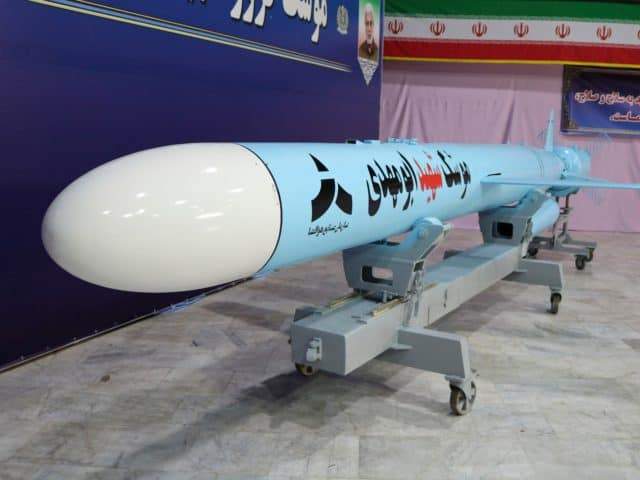Iran Unveils Two New Missiles Named for Terror Chiefs Slain in U.S. Strike

Iran unveiled new missiles Thursday named for two generals killed in January after a U.S. strike on their convoy outside Baghdad airport.
Iran state TV displayed images of a surface-to-surface ballistic missile as Defence Minister Amir Hatami claimed it had a range of 1,400 kilometres and a separate new cruise missile, ignoring U.S. demands Tehran halt its missile program.
“The surface-to-surface missile, called martyr Qasem Soleimani, has a range of 1,400 km and the cruise missile, called martyr Abu Mahdi, has a range of over 1,000 km,” Hatami said in a televised speech.
Pictures of the missiles were accompanied by captions stating “the newest Iranian cruise missile that will further strengthen Iran’s deterrence power”.
Soleimani, head of Iran’s elite terror outfit Quds Force, and Iraqi militia commander Abu Mahdi al-Muhandis were killed in January in a U.S. strike on their convoy outside Baghdad airport at the direction of President Donald Trump, as Breitbart News reported.
Experts agreed Soleimani’s death was even more significant than al-Qaeda leader Osama bin Laden’s, or Islamic State in Iraq and Syria (ISIS) leader Abu Bakr al-Baghdadi’s.
The Pentagon said Soleimani had orchestrated attacks on U.S.-led coalition bases in Iraq last year, including one on December 27 which killed an American contractor and wounded U.S. service members and Iraqi personnel.
The Pentagon also said Soleimani approved the attacks on the U.S. Embassy in Baghdad that took place earlier this year.
Despite the evidence of Soleimani’s desire to kill U.S. forces wherever they were found in the Middle East, the man who is now hoping to win the 2020 U.S. election said he would have declined to do so:
Now Iran has sought to keep Soleimani’s name alive by emblazoning it on the side of a missile.
“Missiles and particularly cruise missiles are very important for us … the fact that we have increased the range from 300 to 1,000 in less than two years is a great achievement,” said Iranian President Hassan Rouhani.
“Our military might and missile programmes are defensive.”
Iran also inaugurated the production line of its domestically produced “Owj” engine for the Iranian-made twin-seat Kowsar fighter jet.
The additions to Iran’s defense capabilities came after U.S. Secretary of State Mike Pompeo said on Wednesday Trump has directed him to trigger ‘snapback’ – a return of all U.S. sanctions on Iran – at the U.N. Security Council in New York on Thursday, after the council rejected Washington’s bid to extend Tehran’s arms embargo.
Photo: Iranian Defense Ministry via AP











